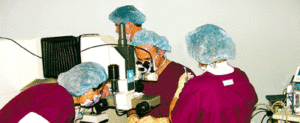Philadelphia / Bucks County LASIK Surgeon – Dr. James S. Lewis
Eye News Volume I Issue 8

Laser Clean Room eliminates contaminants during surgery
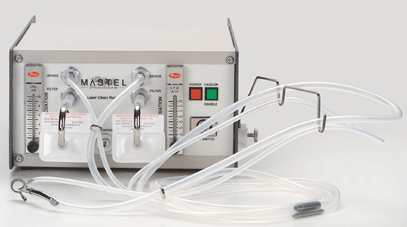
Microscopic environment controlled to optimize results
JENKINTOWN, PA _ The Mastel Laser Clean Room was designed to remove potentially harmful airborne debris from the LASIK operating suite. It works.
“I was happy with the added safety this unit provided my patients and staff. That would have been enough”, said James Lewis, MD, a LASIK specialist. “I didn’t expect this device to improve my clinical results.”
Lewis continues, “Doug Mastel insisted I’d have better post-operative outcomes…. He’s correct and now it all makes sense.”
During LASIK the excimer laser is applied in a series of pulses. After each pulse vaporized corneal tissue rises from the surface. Pulses occur so rapidly they hit the rising particles from the previous pulse. The laser energy delivered to the cornea is distorted and inefficient.
“It is like driving through fog. The headlights work but resolution is impaired”, Lewis claims. “Elimination of this particulate debris allows each laser application to remove the planned amount of corneal tissue without distortion.”
The Laser Clean Room creates a controlled microscopic environment for LASIK. The particles are absorbed before the next pulse is applied. This ensures stabilized corneal hydration and reliable excimer corneal sculpting.
“The hot buzz word today is eye tracker. Mastel uses fixation [see the handpiece below] and the best supercomputer I know to optimize placement of laser energy. That supercomputer is the union of the patient’s feedback and the surgeon’s years of experience. This helps explain the improved results.”, Lewis said.
“The patients are reassured because we help them hold their eye still”, claims Sue Cross, head LASIK coordinator. “I can feel their anxiety lift when they learn we are in total control.”
The fiber optic visualization system Mastel added took years to perfect. This enhanced view helps the surgeon.
“The light source included makes it easy to center the laser energy. This is fundamental for patients with large pupils and night driving concerns”, claims Lewis. “I can be certain the ablation is well positioned and the interface is immaculate.”
Mastel Precision is known for innovation and the development of quality products. A decade ago their diamond blades and Radial Keratotomy instrumentation was without peer. Doug Mastel and his brother are engineers and they closely supervise and direct all research and development.
“I am relieved there is still a place for this kind of pride, dedication, and perfectionism in our field. I feel like I have a partner in every surgery”, Lewis said.
Surgeons throughout the country are reporting an improvement in visual results using the Laser Clean Room. Many feel their enhancement rate is reduced because the surgical micro-environment had been made more uniform.
“There is less visual fluctuation, less regression, and greater accuracy now that I use it [Laser Clean Room] in every case”, Lewis stated. “I don’t think my staff or my patients would tolerate it any other way.”
“I was happy with the added safety this unit provided my patients and staff. That would have been enough”, said James Lewis, MD, a LASIK specialist. “I didn’t expect this device to improve my clinical results.”
Lewis continues, “Doug Mastel insisted I’d have better post-operative outcomes…. He’s correct and now it all makes sense.”
During LASIK the excimer laser is applied in a series of pulses. After each pulse vaporized corneal tissue rises from the surface. Pulses occur so rapidly they hit the rising particles from the previous pulse. The laser energy delivered to the cornea is distorted and inefficient.
“It is like driving through fog. The headlights work but resolution is impaired”, Lewis claims. “Elimination of this particulate debris allows each laser application to remove the planned amount of corneal tissue without distortion.”
The Laser Clean Room creates a controlled microscopic environment for LASIK. The particles are absorbed before the next pulse is applied. This ensures stabilized corneal hydration and reliable excimer corneal sculpting.
“The hot buzz word today is eye tracker. Mastel uses fixation [see the handpiece below] and the best supercomputer I know to optimize placement of laser energy. That supercomputer is the union of the patient’s feedback and the surgeon’s years of experience. This helps explain the improved results.”, Lewis said.
“The patients are reassured because we help them hold their eye still”, claims Sue Cross, head LASIK coordinator. “I can feel their anxiety lift when they learn we are in total control.”
The fiber optic visualization system Mastel added took years to perfect. This enhanced view helps the surgeon.
“The light source included makes it easy to center the laser energy. This is fundamental for patients with large pupils and night driving concerns”, claims Lewis. “I can be certain the ablation is well positioned and the interface is immaculate.”
Mastel Precision is known for innovation and the development of quality products. A decade ago their diamond blades and Radial Keratotomy instrumentation was without peer. Doug Mastel and his brother are engineers and they closely supervise and direct all research and development.
“I am relieved there is still a place for this kind of pride, dedication, and perfectionism in our field. I feel like I have a partner in every surgery”, Lewis said.
Surgeons throughout the country are reporting an improvement in visual results using the Laser Clean Room. Many feel their enhancement rate is reduced because the surgical micro-environment had been made more uniform.
“There is less visual fluctuation, less regression, and greater accuracy now that I use it [Laser Clean Room] in every case”, Lewis stated. “I don’t think my staff or my patients would tolerate it any other way.”
Doug Mastel’s
device enhances LASIK safety for patients, staff, and your surgeon
device enhances LASIK safety for patients, staff, and your surgeon
RAPID CITY, South Dakota- LASIK is effective because unwanted corneal tissue is painlessly removed. The aerosilized material is called the plume.
Live oral polio virus has been found to survive and remain infectious in the LASIK plume. MJ Travella, a respected researcher specializing in the properties of the excimer laser plume has eliminated most of our worries concerning transmission of other serious disease entities.
Responsible surgeons protect their staff, their patients, and themselves with multiple safety mechanisms.
LASIK’s excellent history and safety profile are encouraging. Mastel, however, designed the Laser Clean Room to remove unwanted compounds. Their Ultra Low Penetrating Air (ULPA) filters remove 99.9999+% of particles down to one-tenth of a micron. Viral particles, carcinogenic hydrocarbons, and aromatic hydrocarbons are eliminated.
HEPA filters, common in other laser plume evacuators address only 98.7%. Material three times larger than those handled by ULPA filters get past the HEPA devices. These escaped compounds can enter the lungs and bloodstream.
“I can smell the difference”, said Debbie Breig. Ms. Breig, an outstanding scrub nurse who has worked at Wills Eye and has assisted in LASIK before joining Advanced Laser Vision.
“I am more confident that potentially dangerous debris is removed before it can reach the patients and the staff”, Breig continues.
Mastel has also added an carbon activated filter to the system. It removes non-biologic substances.
OSHA, the federal agency regulating safety in the workplace, recommends thorough excimer laser plume evacuation.
Live oral polio virus has been found to survive and remain infectious in the LASIK plume. MJ Travella, a respected researcher specializing in the properties of the excimer laser plume has eliminated most of our worries concerning transmission of other serious disease entities.
Responsible surgeons protect their staff, their patients, and themselves with multiple safety mechanisms.
LASIK’s excellent history and safety profile are encouraging. Mastel, however, designed the Laser Clean Room to remove unwanted compounds. Their Ultra Low Penetrating Air (ULPA) filters remove 99.9999+% of particles down to one-tenth of a micron. Viral particles, carcinogenic hydrocarbons, and aromatic hydrocarbons are eliminated.
HEPA filters, common in other laser plume evacuators address only 98.7%. Material three times larger than those handled by ULPA filters get past the HEPA devices. These escaped compounds can enter the lungs and bloodstream.
“I can smell the difference”, said Debbie Breig. Ms. Breig, an outstanding scrub nurse who has worked at Wills Eye and has assisted in LASIK before joining Advanced Laser Vision.
“I am more confident that potentially dangerous debris is removed before it can reach the patients and the staff”, Breig continues.
Mastel has also added an carbon activated filter to the system. It removes non-biologic substances.
OSHA, the federal agency regulating safety in the workplace, recommends thorough excimer laser plume evacuation.
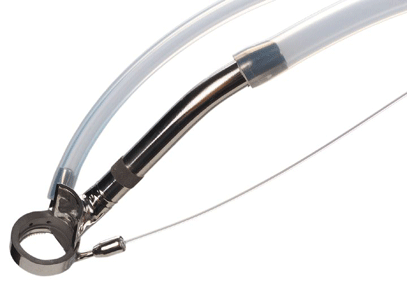
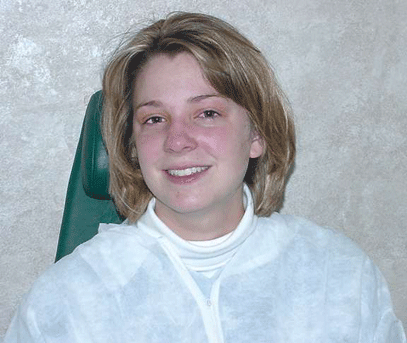
Dr. Jamie Ellsworth-Neiman is reassured that her LASIK was performed using the Laser Clean Room.
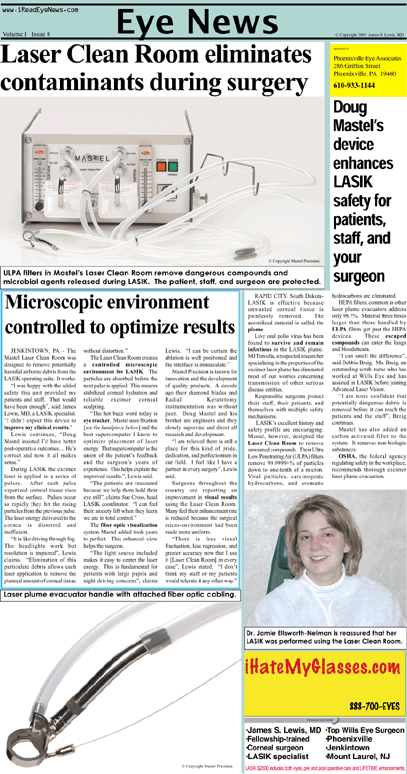
At Dr. Lewis’ state-of-the-art LASIK Philadelphia offices, patient safety is of the utmost importance. This is why he uses sophisticated equipment for microclimate control and enhanced precision of surgical procedures. This approach has helped Dr. Lewis establish a reputation as a leading Philadelphia / Bucks County Epi-LASIK, LASIK and Visian ICL surgeon.

